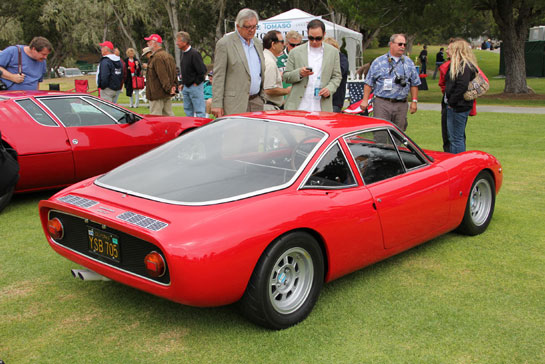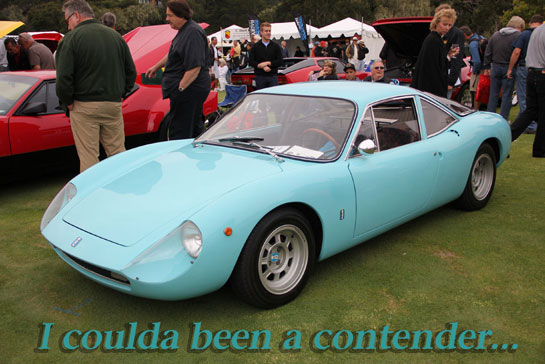By Wallace Wyss
Photos by Hugues Vanhoolandt
At the 2011 Concorso Italiano, there were no less than two, count ‘em, two DeTomaso Vallelungas. Few of the show-goers realized what they were, because for most Americans the only DeTomaso car they know is the mid-engined Ford powered Pantera.
The Vallelunga—pronounced “VALLEY-LUNG-GUH–was the first production DeTomaso, coming seven years before the first Pantera prototype was built.
Alejandro DeTomaso first built a two seater racer, a barchetta, which made its debut at the Turin Motorshow in 1963. This car was made of aluminum. Prior to that DeTomaso and his wife, the former Isabelle Haskell, had made only race cars, and in effect, with OSCA’s development testers, were working for OSCA. In 1959, they left OSCA and began to make cars under their own badge, either for F2 or Formula Juniors, or even, on occasion, F1.
De Tomaso originally planned to build the Vallelunga, (named after a racetrack in Italy at which the roadster had some success), with aluminum coachwork, as a roadster with a removable hardtop but instead he put a coupe into production. The first three were bodied in aluminum by Fissore, and had the rear section lifting a la GT40. But then Fissore and DeTomaso had a falling out, and DeTomaso went over to Ghia in Turin, a firm he subsequently bought when he was able to secure a line of credit from his wife’s wealthy family in America.
The frame consisted of sheet metal, the main member a rectangular section spine running from one axle line in back to that of the front with front and rear subframes attached at either end of the spine, to which suspension members are attached. The mid-mounted engine was a stressed member of the chassis, not an uncommon racing practice, and even more desirable if you had an iron block engine.
Colin Chapman had also produced a spine-framed Europa but if you compare the frames, the Europa frame has splayed out appendages, and was a better design. His mid-engined car was more successful compared to the Vallelunga, but the Europa didn’t come out until 1966, so it probably was the front engine Elan’s spine frame that influenced DeTomaso.
The Europa was the first mass-produced mid-engine road car and DeTomaso no doubt admired Chapman’s philosophy of automotive design: “Simplify, then add lightness.” DeTomaso beat Chapman to the concept of spine frame mid-engine time-wise but his quantities were so small that the Vallelunga’s contribution to the state of the art of mid-engined cars was negligible.
This author has seen a picture of DeTomaso with Chapman but one of the reasons no business transpired between them was that both were rivals for Ford money, as it was known as early as 1963 that Ford was going to go after Ferrari at LeMans. Chapman ended up getting Ford money for an Indy car, and DeTomaso money for the Pantera, a road car.
But I digress. Back to Vallelunga history. Over at Ghia, the body was changed in two respects—first it was changed to fiberglass and secondly the rear section no longer lifted a la GT40 but instead only the glass hatch lifted to provide engine access.
The engine was the Ford Cortina 1500 cc four cylinder, rated at 104 hp though word was it could be tuned to produce as much as 135 hp. The gearbox was VW-derived, changed into a five-speed by De Tomaso. The brakes were by Campagnolo.
The build quality of the body was surprisingly good, since fiberglass was a new media to Ghia, but the interior was“kit car” especially the wood on the console. The steering wheel looked like a race car wheel and the gated shifter was oh-so-racing Ferrari.
This writer remembers seeing two of them in Hollywood back in the Sixties, probably both belonging to the Dean Martin family. Singer Dean Martin had two sons by his second marriage. According to Internet sources, son Ricci was given a Vallelunga coupe for his sixteenth birthday which was almost immediately destroyed in an accident. Ricci was given another new red Vallelunga, three weeks later.
The only significant thing about the Vallelunga, really, is that it was the car got DeTomaso’s in-laws, the immensely rich Haskell family (Once you know there is a horse race named after them at Monmouth Park, a track founded by the Haskells, you know they are wealthy) off the dime to start invest in their son-in-law’s business. DeTomaso bought Ghia with their investment funds and in 1969 sold Ghia to Ford for a fat profit. Ford used Ghia as a studio to develop future Ford products. Both DeTomaso and the Haskells made money off the deal and Mrs. DeTomaso’s brother joined the firm to help market the Vallelunga’s successor, the Mangusta. Ford more or less reduced the value of the badge “Ghia” to nothing by over-using it on various production cars that had a tenuous or almost fictional relationship to the great Italian coachbuilder.
Like Marlon Brando in On the Waterfront, the Vallelunga “coulda been a contender” if DeTomaso had made enough of them to be counted by the FIA as a production car. All he had to make in one year was 50 and indeed he made at least 52 (other sources say 56 while David Burgess-Wise quoted 180) but not in one year.
The Vallelunga is a case of “woulda, coulda, shoulda” in that it woulda been a competitive car to Porsche if it had a more powerful engine, it coulda carved out a market for itself, and DeTomaso shoulda spent more money on refining it. The car was light enough, at 1600 lbs. but compare it to any mid-engined Porsche and it didn’t have the power, nor was DeTomaso willing to cast up his own engines and improve them like Porsche, who virtually owned the classes in that engine size except for the occasional intrusion of Abarths into the finishing ranks.

But in the end, the promise of the Vallelunga was extinguished by the Mangusta project. Photo by Hugues Vanhoolandt.
Typical of the mercurial DeTomaso, he was off to other projects before the Vallelungas finished production, such as the V8-powered Mangusta with styling by Giugiaro, so he lost interest in the Vallelunga completely.
A sort of backhanded compliment to the Vallelunga came when the vaunted New York Museum of Modern Art exhibited it as “an example of technological progress and outstanding design.”
DeTomaso was always running too fast, and too loose to ever concentrate on anything for long and so as a result the DeTomaso Vallelunga remains as only an interesting footnote in Italian postwar sports car history, a car with loads of unfulfilled promise….
The Author: Wallace Wyss is the author of FERRARI HUNTERS, a novel set in the world of collector Ferraris. It is available from www.albaco.com

i remember well the de tomaso – osca 1100 racer that mr.scott (bill i think) used to run at elkhart in the mid 1960’s. very pretty car. it was called “scuderia tin can”. somebody used the bodywork to make molds to make fiberglas replicas, i can’t remember the details.
haskell – yes a famous name in NJ – NY racing (my father in law used to work for whitney enterprises including the elmont NY operation). there was also a chicago branch of the family, my great-aunt regina crandall taught english at bryn mawr for many years, she had many devoted students over the years, one of them being one of the haskell girls. upon her retirement the girls got together & established a trust fund for her so she could live in some comfort after retiring. regina had no children, eventually the residue of the fund came down to me which has kept me going for the last 17 yrs or so with some educational gifts to my children etc.
> jack
I owned a Vallelunga while living in San Jose, CA around 1980 and enjoyed the car greatly as it was light and handled very well by the standards of the time. No way there were 180 of them the under 60 total is closer to reality. The car simply screamed for more power SO I put a Lotus Twin-Cam in it–fit like it was made for it
and the resulting car(bored/stroked 1,750cc engine) with 165hp at 6,500rpm was
very quick with a roughly 0-60 time of below 6secs! That was all the car needed to be a winner BUT Chapman and Lotus beat DeTomaso to it with the Elan an even
better hendler and 100#s lighter due to the large glassed in rear body of the Vallelunga which was heavy and unbalanced the car just a bit! All in all the Valle-
lunga had a lot of potential but DeTomaso’s lack of attetion to finishing the job was
finishing the car–to bad huh?
gee if they had only put an osca 1.6 litre in the valle.
having been the dissatisfied owner of a lotus twincam i would not recommend going to 1750, steel billet crank required, natch,
the silly bicycle chain driving 2 cams was a mistake, any italian knows a duplex roller chain is required. my 1974 toyota has duplex rollers for pete’s sake. i broke many camshafts with that cosworth mk.13 (dry sump version) & finally cracked a piston & burned a hole thru it, mucho smoke in the cockpit/
> jack
Col. ronnie Hoare, in the UK, who owned the Ferrari concession (I think the first one in the UK) also bought a Vallelunga and put a twin cam Lotus engine in it but I think his plan for developing a sort of low cost alternative to a mid-engined Ferrari fell apart when he discovered how marginal the car was built. For instance, did you know the steering wheel was held onto the steering column with a set screw! That’s engineering! My favorite DeTomaso story is from when he was supplying Ford with Panteras. Whenever the engineers at Ford would complain about some marginal engineering on the Pantera he would say “What do I know–I’m just a designer” and then when over at Design they could complain about some aspect of the design he’d say “What do I know–I’m jsut an engineer.”